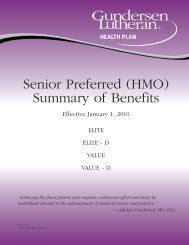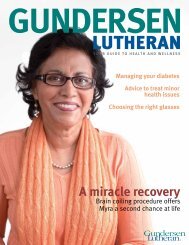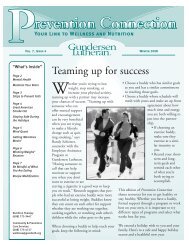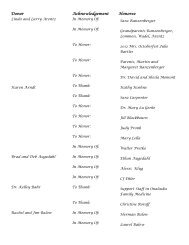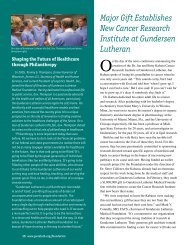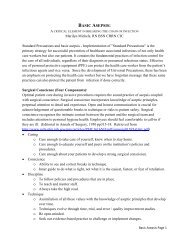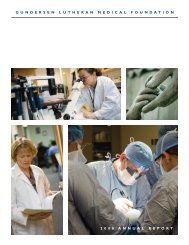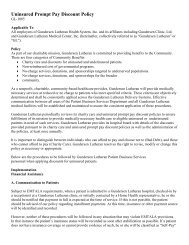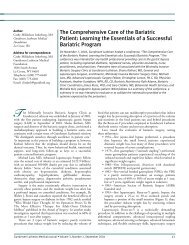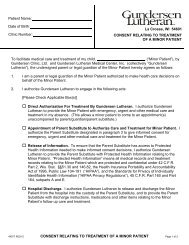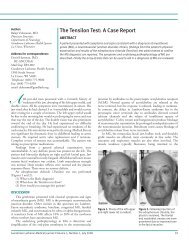ndersen er an - Gundersen Health System
ndersen er an - Gundersen Health System
ndersen er an - Gundersen Health System
Create successful ePaper yourself
Turn your PDF publications into a flip-book with our unique Google optimized e-Paper software.
Authors:<br />
Jennif<strong>er</strong> S. Mattingley, MD<br />
Int<strong>er</strong>nal Medicine Residency<br />
Gu<strong>nd<strong>er</strong>sen</strong> Luth<strong>er</strong><strong>an</strong> Medical<br />
Foundation<br />
La Crosse, Wisconsin<br />
Linda C. Groon, MD<br />
Department of Int<strong>er</strong>nal Medicine<br />
Gu<strong>nd<strong>er</strong>sen</strong> Luth<strong>er</strong><strong>an</strong> <strong>Health</strong> <strong>System</strong><br />
La Crosse, Wisconsin<br />
Address for correspondence:<br />
Jennif<strong>er</strong> Mattingley, MD<br />
Int<strong>er</strong>nal Medicine Residency<br />
Gu<strong>nd<strong>er</strong>sen</strong> Luth<strong>er</strong><strong>an</strong> Medical<br />
Foundation<br />
1836 South Avenue<br />
La Crosse, WI 54601<br />
Telephone: (608) 782-7300<br />
Fax: (608) 775-4511<br />
email: jsmattin@gundluth.org<br />
W<br />
W<strong>er</strong>nicke Encephalopathy:<br />
Is the Gu<strong>nd<strong>er</strong>sen</strong> Luth<strong>er</strong><strong>an</strong> Alcohol Detoxification<br />
Protocol Sufficient?<br />
ABSTRACT<br />
<strong>er</strong>nicke encephalopathy (WE) is <strong>an</strong> acute neuropsychiatric<br />
condition resulting from thiamine deficiency.<br />
It is classically charact<strong>er</strong>ized by a symptom triad of ataxia, mental<br />
status ch<strong>an</strong>ges, <strong>an</strong>d ocular abnormalities, although all 3 need<br />
not be present for the diagnosis. Up to 19% of patients with<br />
WE have none of the classic triad of symptoms at presentation<br />
<strong>an</strong>d may present with irritability <strong>an</strong>d fatigue alone. 1-3 Late-stage<br />
findings include hyp<strong>er</strong>th<strong>er</strong>mia, increased muscle tone, <strong>an</strong>d<br />
choreic dyskinesias. 4,5<br />
Thiamine deficiency is common in alcoholics, <strong>an</strong>d th<strong>er</strong>efore<br />
diagnosis <strong>an</strong>d treatment of WE is often focused on care during<br />
alcohol detoxification. Howev<strong>er</strong>, WE has also been well described<br />
in patients with Crohn disease, <strong>an</strong>orexia n<strong>er</strong>vosa, acquired immune<br />
deficiency syndrome (AIDS), hyp<strong>er</strong>emesis gravidarum, <strong>an</strong>d in<br />
patients who have und<strong>er</strong>gone chemoth<strong>er</strong>apy or gastric bypass<br />
surg<strong>er</strong>y. 6 Treatment is aimed at replenishing thiamine stores,<br />
especially to the areas of the brain most susceptible to thiamine<br />
deficiency. Although replacing thiamine is st<strong>an</strong>dard practice in<br />
patients with symptoms suggestive of WE <strong>an</strong>d is often begun<br />
prophylactically in alcohol detoxification, th<strong>er</strong>e is increasing<br />
evidence that traditional dosages of thiamine replacement<br />
are suboptimal in improving outcomes of WE patients. We<br />
present a case report of a patient with WE, review the current<br />
lit<strong>er</strong>ature, <strong>an</strong>d discuss potential ch<strong>an</strong>ges to st<strong>an</strong>dard practice of<br />
thiamine replacement.<br />
CASE REPORT<br />
A 35-year-old white m<strong>an</strong> presented to the em<strong>er</strong>gency<br />
department of Gu<strong>nd<strong>er</strong>sen</strong> Luth<strong>er</strong><strong>an</strong> Medical Cent<strong>er</strong> with<br />
complaints of inability to walk <strong>an</strong>d slurred speech. He had a<br />
history of chronic alcohol abuse <strong>an</strong>d previous alcohol withdrawal<br />
seizures. He stated that he believed he had a seizure 3 days prior<br />
We describe the case of a 35-year-old m<strong>an</strong> who presented with central n<strong>er</strong>vous system<br />
symptoms suggestive of W<strong>er</strong>nicke encephalopathy (WE). Aft<strong>er</strong> ruling out oth<strong>er</strong> possible causes,<br />
<strong>an</strong>d based upon clinical findings, WE was diagnosed. WE is caused by a thiamine deficiency<br />
<strong>an</strong>d because thiamine deficiency is common among people who abuse alcohol, thiamine<br />
replacement is a component of Gu<strong>nd<strong>er</strong>sen</strong> Luth<strong>er</strong><strong>an</strong>’s alcohol detoxification protocol. Howev<strong>er</strong>,<br />
review of the lit<strong>er</strong>ature suggests that the current thiamine replacement regimen may not be<br />
sufficient, especially for patients with symptoms of WE.<br />
to his presentation. Since that time he had been unable to walk<br />
<strong>an</strong>d had had multiple falls. He also stated he was unable to “see<br />
straight.” He was, howev<strong>er</strong>, ambivalent about these symptoms.<br />
He had continued to drink alcohol. He stated he was drinking<br />
“less th<strong>an</strong> usual,” but was unwilling to qu<strong>an</strong>tify furth<strong>er</strong>. He also<br />
admitted to not eating for sev<strong>er</strong>al days.<br />
On initial examination he was awake <strong>an</strong>d oriented to p<strong>er</strong>son.<br />
Vitals included heart rate of 120 beats p<strong>er</strong> minute <strong>an</strong>d blood<br />
pressure of 139/102 mm Hg. The patient was afebrile. Neurologic<br />
examination revealed marked v<strong>er</strong>tical, horizontal, <strong>an</strong>d rotary<br />
nystagmus. Bilat<strong>er</strong>al sixth cr<strong>an</strong>ial n<strong>er</strong>ve palsies w<strong>er</strong>e present.<br />
Function of the remaining cr<strong>an</strong>ial n<strong>er</strong>ves was intact. Strength was<br />
normal in the upp<strong>er</strong> <strong>an</strong>d low<strong>er</strong> extremities. Occasional choreiform<br />
movements of the left upp<strong>er</strong> extremity, especially with provocation,<br />
w<strong>er</strong>e noted. Deep tendon reflexes w<strong>er</strong>e brisk but without clonus,<br />
<strong>an</strong>d Babinski sign was absent bilat<strong>er</strong>ally. Th<strong>er</strong>e was marked bilat<strong>er</strong>al<br />
upp<strong>er</strong> extremity ataxia <strong>an</strong>d gait ataxia. Because of truncal ataxia, he<br />
could not sit up without support. He had marked dysarthria with a<br />
paucity of spont<strong>an</strong>eous speech. Due to his marked dysarthria <strong>an</strong>d<br />
poor level of coop<strong>er</strong>ation, it was difficult to fully assess cognition.<br />
On skin examination, multiple areas of ecchymosis <strong>an</strong>d abrasions<br />
w<strong>er</strong>e noted on his extremities, trunk, <strong>an</strong>d face.<br />
Laboratory test results showed a white blood cell (WBC)<br />
count of 14 500/μL, hemoglobin concentration of 17.9 g/dL, <strong>an</strong>d<br />
a platelet count of 102 ×10 3 /μL. Potassium was markedly depleted<br />
at 2.4 mEq/L. Sodium was 134 mEq/L, chloride 80 mEq/L, <strong>an</strong>d<br />
magnesium 2.0 mEq/L (decreased to 1.3 mEq/L within 48 hours).<br />
Oth<strong>er</strong> electrolyte <strong>an</strong>d glucose values w<strong>er</strong>e within ref<strong>er</strong>ence r<strong>an</strong>ge.<br />
Aspartate aminotr<strong>an</strong>sf<strong>er</strong>ase (AST) <strong>an</strong>d al<strong>an</strong>ine aminotr<strong>an</strong>sf<strong>er</strong>ase<br />
(ALT) concentrations w<strong>er</strong>e marginally elevated at 73 U/L <strong>an</strong>d 51<br />
U/L, respectively (Table). Int<strong>er</strong>national normalized ratio (INR)<br />
was slightly elevated at 1.2. Findings from noncontrast computed<br />
Gu<strong>nd<strong>er</strong>sen</strong> Luth<strong>er</strong><strong>an</strong> Medical Journal • Volume 5, Numb<strong>er</strong> 1, July 2008 13




